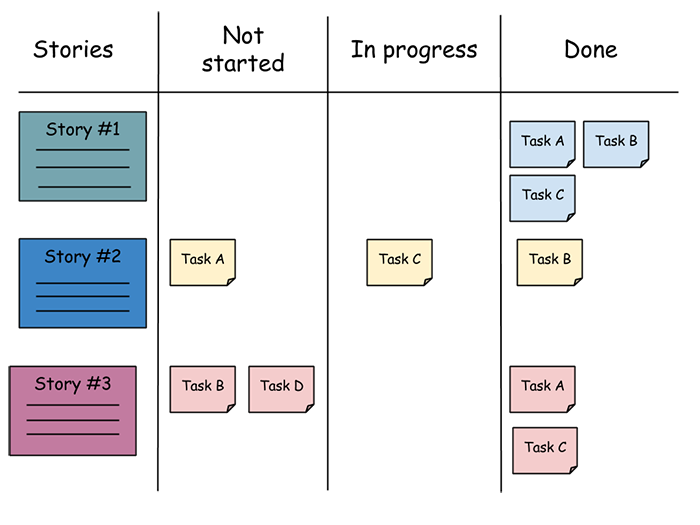Yuriy Veligorskyi is an Agile coach and Scrum trainer, a guest lecturer at Advance Business School in Agile/Scrum. He helps create Agile culture and build flexible processes in both IT and non-IT companies, enabling teams to become more effective, continuously improve their products, and increase business efficiency.
About Agile
Agile is a philosophy with specific views and values that teams should follow for effective work. It does not contain specific instructions. Its foundation is the 12 principles and 4 values described in the “Manifesto for Agile Software Development”.
In Agile, all work is based on four core values:
- Individuals and interactions over processes and tools.
- Customer collaboration over contract negotiation.
- Working software over comprehensive documentation.
- Responding to change over following a plan.
When you are a small company or startup, this might not be difficult. Large companies have two options: achieve results through strict and prolonged directives or make your employees happy, allow them to influence processes, give feedback, and have a clear direction on where and how to go. In short, this is Agile.
It is important to remember that Agile should not be the goal. Primarily, you need to strive for changes in organizational culture, openness, and transparency.
Scrum and Other Smart Words…
Scrum, Kanban, LeSS, SAFe, and other smart words are ways to organize work in the spirit of Agile.
Scrum is often called a methodology, but it is not. Scrum is a framework, a process template, or a process skeleton. It is a framework description of how you should work to achieve your goal. While using this framework, you can add something of your own that does not contradict the structure and values of Scrum.
Why Do You Need an Agile Coach?
People often ask: “What is an Agile coach?”. The term consists of two words. We have already figured out Agile. A coach is a guide, a person who helps to reach a goal and promote positive changes. Initially, it may seem like a “traditional consultant,” but there is a fundamental difference. A consultant tells you what to do, while a coach helps the client get to where they want to go. You could say an Agile coach is a trainer, teacher, mentor, facilitator, and Agile expert all in one. They work both at the team and organizational levels.
The job of an Agile coach is not just working with a team but involves deep organizational changes across the entire company.

Agile Only for IT?
Yes, there is an opinion that Agile is only suitable for IT industries. This belief is based on the fact that the Agile movement was created by a group of developers. But today, these principles are followed by various companies worldwide. Successful experiences in banking, insurance, healthcare, and many other sectors show that Agile can be applied anywhere, regardless of the company, country, or industry.
What Problems Does Agile Solve?
Many managers want people to work quickly and efficiently, be ready for uncertainties, and have clear processes. They also want interactions to be open and transparent. Sounds great, right?
Agile addresses all these needs. Agile is not a final state but a way of thinking and living.
How to Start “Flexible Changes”?
It’s important to understand that Agile, like any other cultural change, does not happen with a wave of a magic wand. Agile transformation is a full-fledged project and quite time-consuming. The smaller the company and the smaller the division, the easier and faster the transformation will take place. In large companies, transformation can take 3 – 5 years. Unfortunately, you can’t just plan to become Agile and expect it to happen by itself in six months.
Start by understanding where your company is now and where it wants to be after the transformation. Build a path between these two points to create a specific action plan.
Visualization Tools
A board is just a tool to visualize everything as much as possible.

It can be on a flipchart, a wall, or in electronic form. Each team chooses the board that suits them best. But the most important thing is that it improves interaction among team members.
The choice of board depends on the team, budget, situation, and number of participants. For electronic boards, free or conditionally free options include Trello and Redmine, each with its own features. Well-known companies like VersionOne or Jira are also options. Among Ukrainian companies, I would highlight Worksection, which recently released a task board. I hope this product will have killer features that most boards lack, such as limiting the number of tasks in a column or per person, or an urgent task lane for high-priority tasks.
About Implementation
A common question is: “What is needed for Scrum to work?” Here’s the secret: there is no silver bullet. Cultural changes are always the most difficult and time-consuming. You can’t just come to work and say, “Today we have a Scrum training, and in three days we will start working with Scrum.” No, it doesn’t work like that. Agile is not a switch that you can flip and say, “We have become Agile.”
This story is more about how modern leaders can create an environment that engages teams in creating quality products for your customers.
With Agile approaches, modern leaders create an atmosphere in the organization that inspires people to achieve goals. Employees are not afraid to propose solutions, create something new, and they know they will not be judged for mistakes.
Agile is not: “Coach, do something with my people.” It is rather: “Coach, help me become a better leader so I can create an engaging environment, learn to listen to my people, and make a great team out of them.”
Recommended Books:
- Jeff Sutherland, “Scrum: The Art of Doing Twice the Work in Half the Time”
- Patrick Lencioni, “The Five Dysfunctions of a Team”
- Henrik Kniberg, “Scrum and XP from the Trenches”

